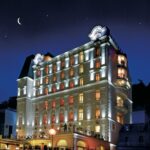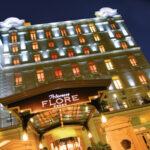The olden days of grand hotels have long faded away, but Royat is one of the few towns in Auvergne where many of these towering architectural time capsules remain, silently offering glimpses into a gilded era that has been thoroughly romanticised by Titanic and other Hollywood films. Among these glamorous edifices is the Princesse Flore, a five-star hotel that could be described as the “Ritz of the puys”.

The Princesse Flore’s origins date back to 1883. Originally known as the Grand Hotel Richelieu, it was expanded by Auvergnat architects Louis and Marcel Jarrier in the late 1920s. At the time, Royat was one of the premier spa retreats of the international elite; as such, the hotel had the latest technology (such as an electric elevator and a telephone) to keep up with its cosmopolitan clientele. Today, it continues to attract a broad range of patrons, including a number of famous personalities.

In fact, since its acquisition and rebrand by businessman and entrepreneur Isidore Fartaria in 2001, the Princesse Flore has welcomed the likes of Anthony Hopkins, Prince Albert II of Monaco, and the Scorpions, plus dozens of other public figures and music acts.

Several things set the Princesse Flore apart from other resorts in the Chaîne des Puys. In addition to its luxury suites and its ground-floor bar, the hotel has two restaurants — La Flèche d’Argent and Le Grand Prix — as well as a rooftop terrace, the 7th Flore Bar & Lounge. Guests who book a room can also use a private hallway in the hotel’s upper floors to access Royatonic — Royat’s expansive spa and wellness centre.
Yet these aren’t the only features that make the Princesse Flore unique; fans of Art Nouveau painter Alphonse Mucha will find much to love in the reception area, which features Four Seasons-style artworks by local artist François Lassere. The hotel’s renovated interiors — designed by Jean-François Hebrard and Marie-Hélène Espinasse — also incorporate a variety of Art Nouveau-inspired floral patterns and accents.
























